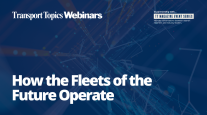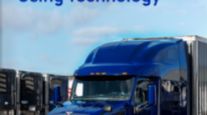iTECH: Solutions for Container Tracking
By Rip Watson, Senior Reporter
This article appears in the April/May 2011 issue of iTECH, published in the April 11 print edition of Transport Topics. Click here to subscribe today.
For fleets that never get near the water, maritime community jargon like “heavy metal,” “cans” and “boxes” could easily be mistaken for slang terms for a music style, headphones, or minivan designs.
Port truckers, on the other hand, recognize those words as synonyms for steel containers, the kind that weigh 30 tons fully loaded and often are stacked 30 feet high over hundreds of acres at marine terminals.
For port truckers, the task of hunting down the right box has long been a challenge, but port operators and technology vendors are installing systems on the tractor and within the terminal to make carriers’ and drivers’ lives easier.
“In the old days, truckers would drive to a place of pickup, wait for a visual identification [of the desired container], and then the RTG [rubber tired gantry crane] operator would be told to go and get the can,” said John Scott, vice president of location and telematics solutions for Zebra Enterprise Solutions, Oakland, Calif. “That could be a time-consuming process.”
The key is radio frequency identification, or RFID, tags and optical character recognition, or OCR, scanners to create the vital link between a truck and the right container. Today, Scott said, information can be relayed by RFID, and OCR equipment is tied into the terminal operating system, or TOS. The advancement was helped by a 2009 mandate from the Califor-nia Air Resources Board for RFID tags on port truckers’ tractors.
Zebra’s TOS, known as Navis, ties together information about vessels, containers, trucks and cranes with the goal of speeding up operations and making them more efficient.
“We are giving visibility about the truck’s location to make the system efficient,” Scott said, referring to the company’s truck processing system, known as WhereNet.
“Instead of hoping the operator did the job given to him,” he said, “you are tracking with GPS [the Global Positioning System] or RFID so that the inventory is accurate. There is no longer the question of whether [a container] is two or three high in the stack.”
Tracking within ports is complicated by the containers themselves, however, as stacks of them can block radio waves and make retrieving a specific container a difficult proposition, said Red Smith, CEO of ContainerTrac Inc., Richmond, Calif.
“A seaport or rail yard or inland depot that has stacked containers is an extremely challenging environment to track anything,” said Smith, whose company sells its own truck-based equipment-tracking solutions. Complicating the process is the dynamic movement of containers and tractors around the terminal.
“In a seaport, the walls are changing all the time,” he said, noting that the metal obstacles that have to be overcome aren’t in a fixed location like in a warehouse with a single set of walls. “The only way to solve that ‘Where is the container?’ puzzle is to attach a tracking device to the tractor. That is the only way to get the turn time for the supply chain to be the most efficient.”
His firm now is doing a pilot project with a West Coast terminal operator that he declined to identify. The test began in December and should be completed in June.
Other companies’ services focus on terminal operations. Robert Huffman, vice president of terminal operations for Norfolk Southern Corp., Norfolk, Va., told iTECH that installing an automated gate system reduced the time a trucker spent at a terminal in Portsmouth, Va., to less than one minute from two or three minutes. In total, NS cut the time from a trucker’s entry to a terminal until his exit to 25 minutes from 40 minutes.
Gains that were achieved were more than just installing RFID tags.
“We changed a lot of processes,” Huffman said, such as substituting digital images of containers to keep track of damage instead of having a person do a mechanical inspection and fill out a report. Ideally, he said, “the process is almost nonstop.”
At the terminal, the truck and its container are identified at an OCR “porthole,” Huffman said. The information is then sent to the terminal operating system, speeding up the process to the point that the trucker knows exactly where he needs to go before actually entering the terminal itself.
Tideworks Technology Inc., Seattle, offers a system, called GateVision, which works with its TOS, the latest version of which, Mainsail Vanguard, was introduced in November. Tideworks’ latest installation is at CSX’s northern Ohio intermodal terminal, which opened in February.
Harvey Bauer, marketing director for Tideworks, emphasized advancements that offer flexibility for terminal operators such as interactive kiosks with keyboards and touch screens to give drivers several options for entering data.
The many options make it easy for drivers to confirm that the automated data capture transaction is correct and to make changes if needed.
“The system is very modular and flexible,” he said.
It’s also adaptable to several terminal operating systems and is particularly suited to so-called “kitchen” systems. In those systems, a clerk in a central terminal office known as a kitchen manipulates the camera for each gate transaction and then enters that information into a TOS.
Jack Craig, chief operating officer for Netherlands-based APM Ter-minals, stressed the importance of marrying these technological solutions with sound management practices. APM has been developing a system of appointment times for truckers in conjunction with gate technology and terminal operating systems, he said.
“The key is cooperation,” Craig said, because the appointments are combined with the advantages of the OCR equipment.
“If those two different processes were working independently, it wouldn’t provide the same amount of benefit,” he said. “You’re working constantly to provide the most efficient path [for equipment] through the facility. It takes time to look at the yard configuration to make sure that we created the right traffic patterns. That is just good terminal operations 101.”
Craig said he saw a hopeful sign in the recovery of ocean freight markets last year that has helped companies such as Maersk to post record profits.
“My impression is that these [technological] initiatives had more momentum before the economic downturn,” Craig said. “As volumes start to come back and continue along on a growth path, stakeholders will come together again and explore more ideas along these lines.”




